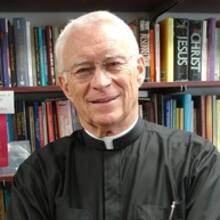Can We Talk?
One of the most interesting religious developments in the late 20th century has been the warming of relationships between Roman Catholic and Evangelical Christians. As William Shea says at the beginning of his book, The Lion and the Lamb, both have hated each other in the United States since colonial times. Director of the Center for Religion, Ethics and Culture at the College of the Holy Cross, Shea traces this unhappy history by a careful review of the literature. He argues that both traditions are modern versions of medieval Christianity, so diverse that they are close to being distinct religions, each secure in its own myth, both long caught up in a losing battle with modernity. His treatment of Protestant fundamentalism and the Roman resistance to the emergence of modern historical consciousness is first rate.
Shea traces the Protestant myth (ex tenebris lux) back to the apocalyptic language of the Reformers themselves; the pope was the Antichrist and the Catholic Church an apostate church (Luther and Calvin), the Whore of Babylon (Oliver Ormerod). This is language one can still hear today. In the United States, Evangelical anti-Catholicism was not primarily an expression of nativism; it was built around an inherited tradition Shea calls the "Outline," a series of theological arguments, as well as political concerns about the Catholic Church as a threat to American liberty and the separation of church and state. These fears were only strengthened by the 19th-century papacy, particularly Pope Gregory XVI’s 1832 encyclical,
Mirari Vos, which condemned religious toleration as well as freedom of conscience, opinion and the press.
The Catholic myth (extra ecclesiam nulla salus) assumes that the words of Christ and the authors of the New Testament established the Roman Catholic Church in its completeness--sacramental system, monarchical episcopate and papal primacy. Though threatened by the distortions of heretics throughout its history, this church alone has preserved the truth of the Gospel under the leadership of its papal-episcopal ministry, and its bishops alone have the right to ordain and teach definitively in Christ’s name. It is the true church, unchanging in its teachings and identified by apostolic succession.
Much of The Lion and the Lamb is a rehearsal of Catholic-Evangelical polemics, from John Cotton, Samuel F. B. Morse, Lyman Beecher, Paul Blanshard and mid-20th-century Evangelicals such as Loraine Boettner, John Armstrong and R. C. Sproul, to such Catholic controversialists as Archbishops John Hughes, John England, John Purcell, Cardinal James Gibbons and today’s Karl Keating of Catholic Answers. Distinguishing between "hard Evangelicals," who consider the Catholic Church as apostate, and "soft Evangelicals," who see it as merely heretical, Shea notes the beginning of a shift of attitude toward Catholics with the establishment of the National Association of Evangelicals by Harold Ockenega in 1942. But for him the real turning point was the statement by Charles Colson and Richard John Neuhaus in 1994, "Evangelicals and Catholics Together: The Christian Mission in the Third Millennium," which was willing to recognize at least some Catholics as brothers and sisters in Christ.
In his penultimate chapter Shea shifts the focus from Evangelicals in general to fundamentalists. He notes that the aggressive evangelization of Catholics by fundamentalists is not matched by Catholic efforts, episcopal or otherwise, in their direction. The bishops in his view are defensive rather than evangelical. While he has a good point, his contention that Catholic authors and bishops show little signs of serious interest in fundamentalist or evangelical theology is overstated. Part of the problem is that in the United States, no Evangelical or Pentecostal churches or associations have been willing to enter into a national dialogue with the Roman Catholic Church, except for the Southern Baptist Convention, which carried on a conversation for five years but ended it unilaterally in 2001.
Shea also leaves the false impression that the Vatican is more concerned with talking to "nonthreatening mainline Protestant churches" than with representatives of biblical Christianity, which for him includes both Evangelicals and fundamentalists. He fails to mention that Rome has been carrying on international dialogues with Pentecostals since 1972, Evangelicals since 1977 and the World Evangelical Alliance since 1993. What seems particularly to be missing is an awareness that recent Catholic-Evangelical history and literature is much richer than the Colson/Neuhaus initiative; E.C.T. is not the only game in town.
Shea’s book is a fascinating study of a sad history too often forgotten. He writes well, with a facility of expression and a keen sense of irony. His approach is narrative and historical rather than strictly theological. While his opinions are strong, they are tempered by his love for the church.
In concluding, he tells the story of how his interest was piqued by his first encounter with Evangelicals at the University of South Florida, where some students withdrew from his courses when he was not able to explain to their satisfaction that he had been "born again." A keen observer, he is fair in his critique of both traditions. He is right that Catholic theologians largely ignore fundamentalist Protestant arguments against the Catholic Church, leaving the task of responding to less mainstream apologists like Karl Keating. He speaks of the need to reform both myths and suggests that evangelicalism and Catholicism should be seen as complementary expressions of Christianity, each necessary for the health of the other. In this he may well be right.
This article also appeared in print, under the headline “Can We Talk?,” in the September 27, 2004, issue.








